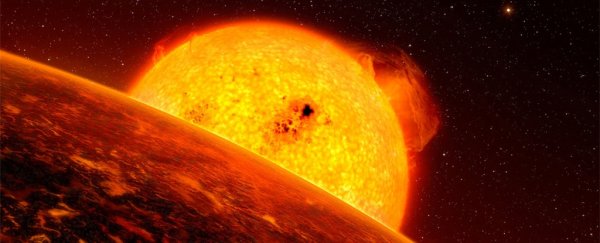NASA scientists have found an exoplanet located somewhere no exoplanet should be able to survive.
The space agency's exoplanet-hunting Transiting Exoplanet Survey Satellite (TESS) has found some pretty neat things in its time on the job so far, including exocomets, a rocky exoplanet with three Suns, and a black hole devouring a star. This new discovery is a real head-scratcher though - they've shown that a known exoplanet is actually located in a position where it should have long ago been burned up by its star.
The planet is a gas giant around 8.2 times the mass of Jupiter (which is pretty large), orbiting the red giant star HD 203949.
The problem is that, according to asteroseismological observations taken by astronomers at the Instituto de Astrofísica e Ciências do Espaço (IA) in Portugal, the star is at the end of its life.
This means it's at a point where it has already started throwing off its outer material, expanding to much larger than its current size before shrinking back down. And the exoplanet's orbit - 184.2 days - is well inside that larger atmospheric diameter it ballooned out to. So how the heck did it survive?
Asteroseismology is a fascinating field that analyses the oscillations on the surfaces of stars to study their internal structures. Just as earthquakes can reveal what's happening inside Earth, oscillation modes detectable on the surface of a star reveal how sound waves are moving inside it.
This data can then help reveal key information about a star, such as its size, mass and age. TESS is equipped with the tools for asteroseismology, but this is the first time the observatory has been used the technique on stars known to have exoplanets.
The observations were conducted on two stars: HD 203949 and its planet HD 203949 b; and a yellow subgiant star called HD 212771, orbited by a gas giant about 2.3 times the mass of Jupiter.
"TESS observations are precise enough to allow measuring the gentle pulsations at the surfaces of stars," explained IA astronomer Tiago Campante. "These two fairly evolved stars also host planets, providing the ideal testbed for studies of the evolution of planetary systems."
So, the team used the asteroseismological data to calculate the size, mass and age of the stars. And, according to that data, HD 203949 has much lower mass than initially thought. That means it's already lost much of it - suggesting it should be far too evolved to have a planet as close as HD 203949 b.
But, if you look beyond the HD 203949 system, there's a giant clue. Many systems have gas giants close to their stars; too close, in fact, to have formed there, because gravity, winds and radiation from the star should have blown and burned away all the gas before it could accrete into a planet.
However, modelling suggests that these gas giants could snuggle up to their stars if they form farther out in their planetary systems and migrate inwards on a slow spiral; evidence suggests Jupiter is doing just this.
So, it's possible that HD 203949b formed much farther out, and only migrated in close to its star after it had already expanded to its maximum size, and shrunk back down again.
"The solution to this scientific dilemma is hidden in the 'simple fact' that stars and their planets not only form but also evolve together," said IA astronomer Vardan Adibekyan.
"In this particular case, the planet managed to avoid engulfment."
The research has not just shown us a really fascinating planet - it has demonstrated TESS's potential for characterising stars using asteroseismology.
This, in turn, could help us better understand planets and their evolution, the researchers said - the accurate radius of a star, for instance, is essential for measuring the accurate radius of a transiting planet.
And, of course, learning the age of HD 203949 has helped infer the orbital history of its unusual planet.
"This study," Adibekyan said, "is a perfect demonstration of how stellar and exoplanetary astrophysics are linked together."
The research has been published in The Astrophysical Journal.
